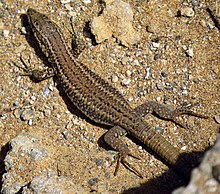
Castellón de la Plana, or simply Castellón, is the capital city of the province of Castellón, in the Valencian Community, Spain. It is located in the east of the Iberian Peninsula, on the Costa del Azahar by the Mediterranean Sea. The mountain range known as Desert de les Palmes rises inland north of the town.

Filfla is a mostly barren, uninhabited islet 4.5 kilometres south of Malta, and is the most southerly point of the Maltese Archipelago. Filflu, a rocky islet some 101 metres southwest of Filfla, has the southernmost point of Malta. The name is believed to come from felfel, the Arabic for a peppercorn.

Benicàssim ; officially Benicasim / Benicàssim) is a municipality and beach resort located in the province of Castellón, on the Costa del Azahar in Spain. The Desert de les Palmes mountain range further inland shelters the town from the north wind.
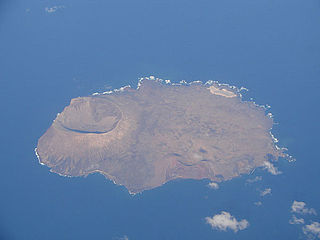
Alegranza is an uninhabited island in the Atlantic Ocean, located off the coast of Africa and is in the province of Las Palmas in the Canary Islands, Spain. It is the northernmost point in the Canary Islands, and part of the Chinijo Archipelago. The island is part of the municipality of Teguise on Lanzarote.

Montgó is a mountain in Alicante Province, Spain, which rises to 753 metres (2,470 ft). It is the last spur on the Cordillera Prebética Mountain Range and is located in the Marina Alta region in the north of Alicante between the towns of Dénia and Xàbia. The mountain rises dramatically from the valley floors surrounding it and dominates the skyline for miles around. Its craggy cliffs are home to some of the most unusual flora and fauna in Spain. The mountain is renowned for its rock formations, cliffs, caves and natural harbours. From the Xàbia side Montgó is often said to resemble the head and trunk of an elephant. The mountain can be easily reached by highway CV-736 which links Denia with Xàbia, both of which are accessible via the AP-7 motorway or the N-332 national highway.

The Columbretes Islands are a group of small uninhabited islets of volcanic origin, in the Mediterranean Sea, 49 kilometres off Oropesa del Mar. Administratively they belong to Castellón de la Plana in the Valencian Community.

The Galite Islands are a rocky group of islands of volcanic origin that belong to Bizerte Governorate, northern Tunisia. They are located 38 kilometres northwest of Cape Serrat, the closest point of the Tunisian mainland coast, from which they are separated by the Galite Channel, and almost 80 km (50 mi) north-by-northeast of the city of Tabarka, and 150 km (93 mi) south of Cape Spartivento in the south of Sardinia. The islands of the group sit atop Banc de Galite.

Lilford's wall lizard is a species of lizard in the family Lacertidae. The species is endemic to the Gymnesian Islands, the easternmost of the Balearic Islands, Spain.
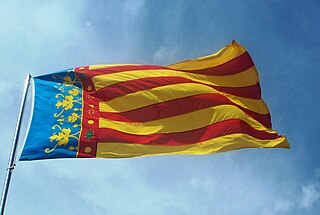
The Himne de l'Exposició or Himne de València is the official anthem of the Valencian Community, Spain. The song was composed by José Serrano Simeón with lyrics written by Maximiliano Thous Orts for the Valencia Regional Exhibition. The music is based on a 16th-century anthem dedicated to Saint George, who was the patron saint of the Kingdom of Valencia. It was approved by the mayors of Alicante, Castellón and Valencia in May 1925, and it was declared as the official anthem of the Valencian Community in 1981, with the approval of the Valencian Statute of Autonomy.
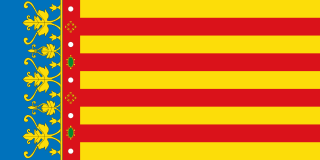
The Valencian Community is an autonomous community of Spain. It is the fourth most populous Spanish autonomous community after Andalusia, Catalonia and the Community of Madrid with more than five million inhabitants. Its homonymous capital Valencia is the third largest city and metropolitan area in Spain. It is located along the Mediterranean coast on the east side of the Iberian Peninsula. It borders Catalonia to the north, Aragon and Castilla–La Mancha to the west, and Murcia to the south, and the Balearic Islands are to its east. The Valencian Community is divided into three provinces: Castellón, Valencia and Alicante.

Desert de les Palmes, also known as Serra del Desert de les Palmes is an 18.8 km long mountain range in the Plana Alta comarca, Valencian Community, Spain. Its highest point is Bartolo.

Torreblanca is a municipality in the province of Castellón, Valencian Community, Spain. The town is located south of the Serra d'Irta mountain range close to the Mediterranean Sea.

The president of the Valencian Government is the head of the Generalitat Valenciana, the government of the Spanish autonomous community of Valencia. The president is chosen by the Valencian parliament, the Corts Valencianes.

The Habibas islands35°43′29″N1°8′00″W comprise a small archipelago of two small, rocky islands, Gharbia and Charguia, located about 12 km off the Algerian coast, north-west of Oran. Administratively, they lie within Bou Zedjar municipality in Aïn Témouchent Province, Algeria. The islands and surrounding waters constitute the Iles Habibas Marine Nature Reserve.

The 2015 Valencian regional election was held on Sunday, 24 May 2015, to elect the 9th Corts of the Valencian Community. All 99 seats in the Corts were up for election. The election was held simultaneously with regional elections in twelve other autonomous communities and local elections all throughout Spain.

This is the results breakdown of the Congress of Deputies election held in Spain on 9 March 2008. The following tables show detailed results in each of the country's 17 autonomous communities and in the autonomous cities of Ceuta and Melilla, as well as a summary of constituency and regional results.
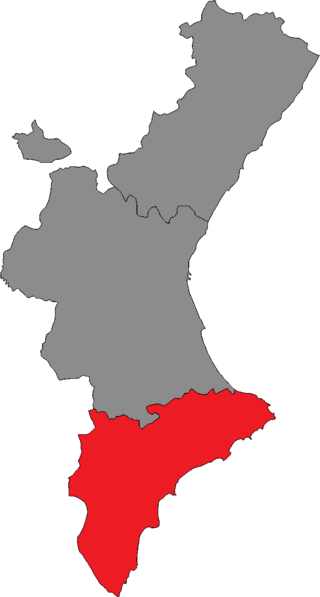
Alicante is one of the three constituencies represented in the Corts Valencianes, the regional legislature of the Valencian Community. The constituency currently elects 35 deputies. Its boundaries correspond to those of the Spanish province of Alicante. The electoral system uses the D'Hondt method and a closed-list proportional representation, with a minimum threshold of five percent regionally.

Castellón is one of the three constituencies represented in the Corts Valencianes, the regional legislature of the Valencian Community. The constituency currently elects 24 deputies. Its boundaries correspond to those of the Spanish province of Castellón. The electoral system uses the D'Hondt method and a closed-list proportional representation, with a minimum threshold of five percent regionally.

Valencia is one of the three constituencies represented in the Corts Valencianes, the regional legislature of the Valencian Community. The constituency currently elects 40 deputies. Its boundaries correspond to those of the Spanish province of Valencia. The electoral system uses the D'Hondt method and a closed-list proportional representation, with a minimum threshold of five percent regionally.

The 2023 Valencian regional election was held on Sunday, 28 May 2023, to elect the 11th Corts of the Valencian Community. All 99 seats in the Corts were up for election. The election was held simultaneously with regional elections in eleven other autonomous communities and local elections all throughout Spain.


